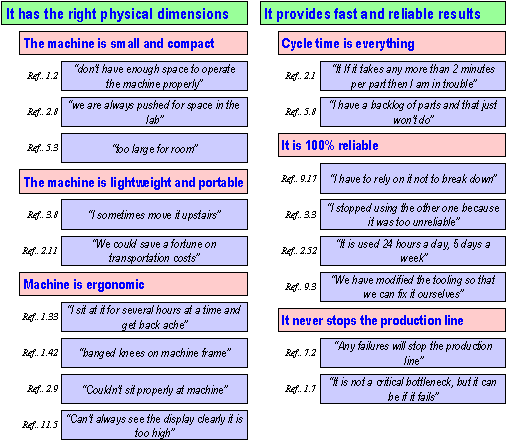Affinity diagrams
Typically, from each customer interview, the team may identify anything from 10 to 100 individual statements which are connected to the product. Each of these statements can be interpreted to identify the underlying need. The affinity diagram is a relatively simple tool to enable these customer needs to be organised hierarchically, based on clustering and group discussion. Most importantly, it helps to build team affinity with the customer requirements.
Method
Assemble the team
Generating an affinity diagram should be a team activity, preferably with input from some representative customers. It can be useful to split the team into pairs, so that people can discuss their insights and confirm their thinking.
Write all customer statements on individual 'post-it' notes
Based on interviews, observation and customer research, write each individual customer statement onto a post it note. There will be a lot, but that is the intention. It is beneficial at this stage to stick to one colour note. Make sure that each statement is referenced, so that the original source can be referred to if necessary.
Group the statements
There are no rules as to how the statements should be clustered. But, there should be no pre-determined category headings to which statements are assigned. The category headings should emerge based upon what is contained within the statements. It can be effective to ban words that the development team are familiar with, such as 'quality' or 'speed'. Typically, the team should aim to have no more than 5-6 statements in a cluster - this will help them to think of alternative clustering arrangements.
Name the group
Give each cluster a 'name', which relates to the statements. A good cluster name is written as though the user is talking to the design team in direct, immediate language. Write the group names on a different coloured post-it note. The group name can be thought of as the interpreted need.
Cluster the groups
There will be many groups and these should be clustered into a higher level cluster. This helps to break down the vast assortment of data into manageable chunks. Again, the clusters should be named to define the specific issue of concern. This hierarchical structure should tell a story about the needs of the user. If there is enough data, further levels of grouping may be required.

For more information, please contact:
T: +44 1223 764830









